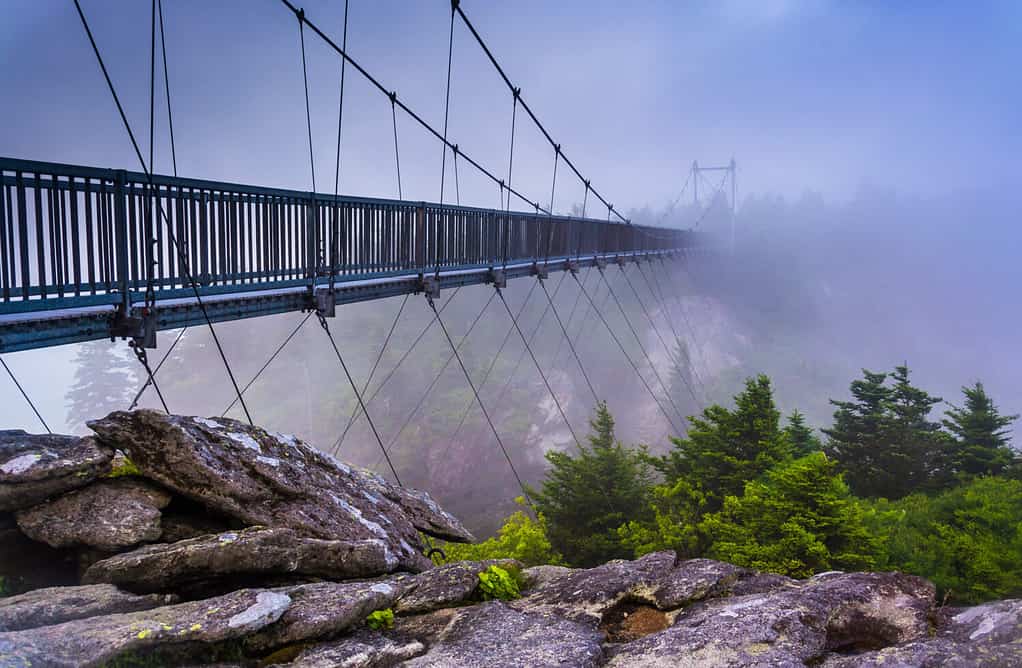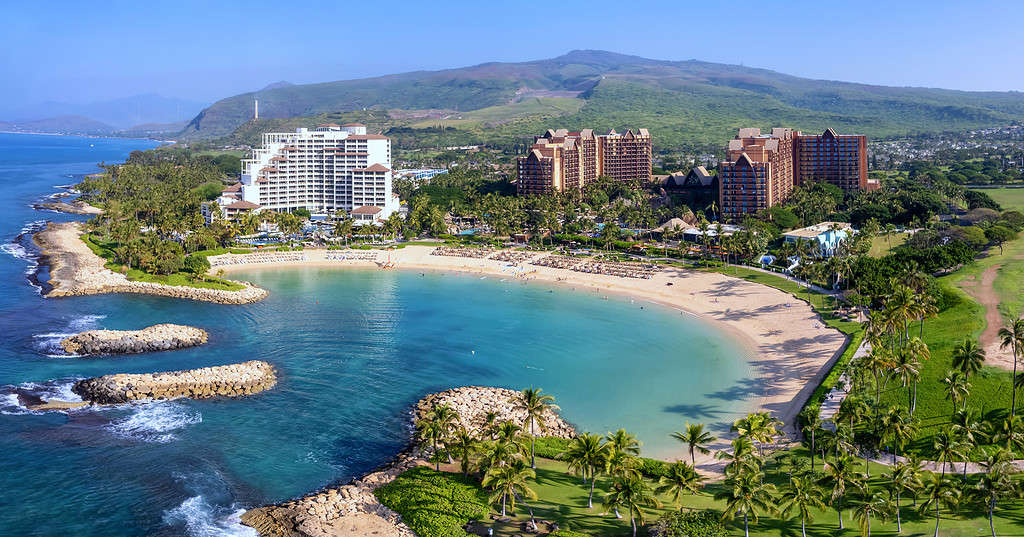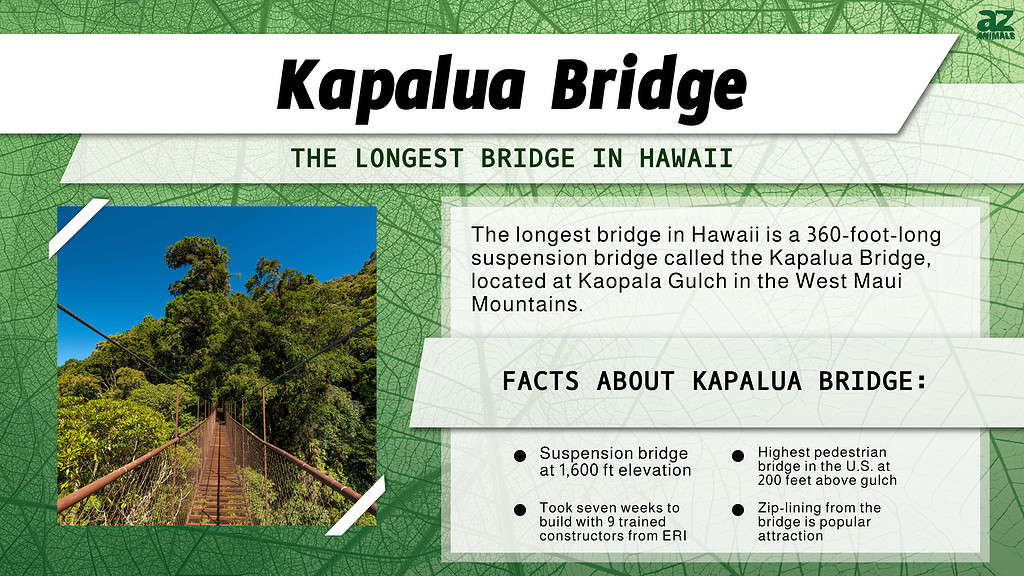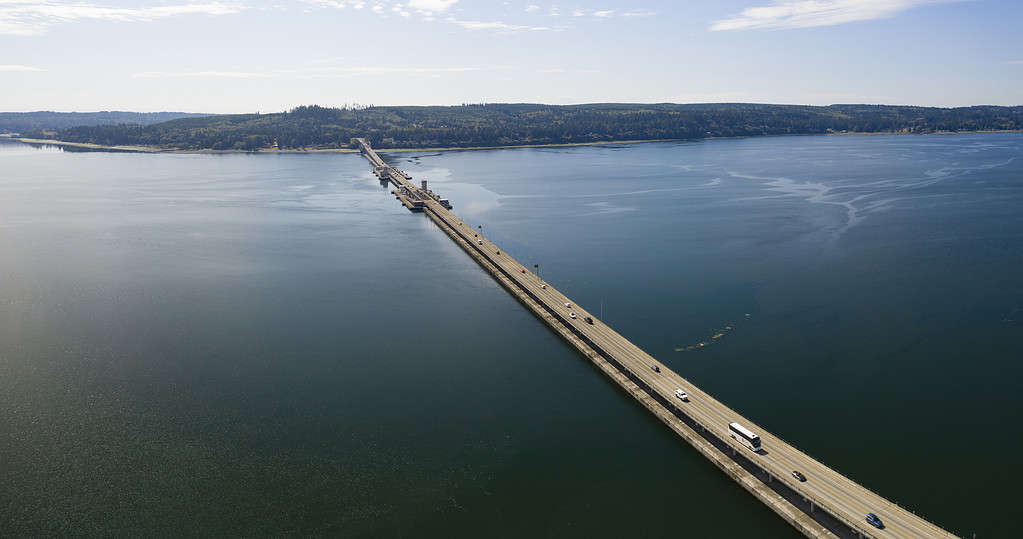The Scariest Bridge in Hawaii Will Have You On the Edge of Your Seat
The Waimea Swinging Bridge is infamously known as the scariest bridge in Hawaii. The bridge gets its name because it crosses the Waimea River.
The Waimea Bridge is the only way to get to the farms on the other side of the river. Tourists cannot visit the farm, but many cross the bridge for a thrilling experience.
Why Is the Waimea Swinging Bridge Scary?

©Jon Bilous/Shutterstock.com
The Waimea Swinging Bridge is scary because it is only held up by two anchors on either side of the river.
There is nothing at the center of the bridge to stabilize it. So, it swings back and forth with travelers’ movements and the wind.
The bridge comprises wood and cables. These materials have more give and are less sturdy than completely metal bridges.
Some travelers note that the wood creaks under your feet as you cross the bridge, which can be unsettling.
The Waimea Swinging Bridge is also very narrow — only three planks wide. But, wooden railings line it on either side.
What is a Swinging Bridge?
A swinging bridge is another name for a suspension bridge. These bridges have been historically known for carrying light loads over long distances.
Swinging bridges are most commonly constructed over water bodies. They are usually seen over fast or deep rivers and extensive canyons or ravines.
These bridges are also common in areas that are difficult to reach. It’s often impractical or impossible to construct a more “standard” type of bridge.
The History of the Waimea Swinging Bridge
Early settlers of the area first built the Waimea Swinging Bridge in 1911. Unfortunately, Hurricane Iniki destroyed the bridge in 1992. Builders recreated the bridge four years later, which closely resembles the original.
Reaching the Bridge
To get to the bridge, you’ll need to drive down Highway 50 after leaving the town of Hanapepe. Take Menehune Road, which is slightly before highway marker 23. The bridge sits less than a mile down the road.
You’ll pass through a residential area to reach the bridge. Slow down and watch for pedestrians, pets, and farm animals.
Most park on the side of the road close to the bridge. There is also an open area slightly before the bridge for cars to park.
The bridge begins at the Menehune Ditch and crosses the river to reach the other side.
Is it Worth Crossing the Waimea Swinging Bridge?
Whether it’s worth crossing the Waimea Swinging Bridge is subjective. Some adventurers like to do it just to say that they have. The height and movement of the bridge, combined with the beautiful views surrounding it, make it worth it to many.
However, the views alone aren’t enough for some.
The farms on the other side of the bridge are private property. You can’t explore the land once crossing the bridge. You can stop for a moment to admire the views and take a few pictures, but you’ll have to travel back almost immediately.
Anyone who tries to explore the farmlands after crossing the bridge will be charged with trespassing.
Even if you don’t feel safe crossing the bridge, it’s still worth visiting. The area surrounding the bridge offers beautiful scenery. It is also a popular area for boaters to launch their kayaks.
Looking for another kind of adventure? Check out Hawaii’s six active volcanoes.
Other Scary Bridges In Hawaii
The Waimea Swinging Bridge isn’t the only scary bridge in Hawaii. Other bridges are frightening because of their length and height, because they float on water, or because they are thought to be haunted.
The Bridge over Kipapa Gulch

©agaliza/iStock via Getty Images
The bridge over Kipapa Gulch just might be the second scariest bridge in Hawaii.
Kipapa Gulch is located in Mililani, a city in O’ahu. The bridge crosses the gulch, which was a major battle site in 1410. Chiefs from Maui and the Big Island attached O’ahu.
The deadly battle caused the gulch to fill with bodies from both armies. O’ahu came out victorious, but locals say the spirits of the fallen warriors still haunt the area.
The “Night Marchers”
Other spirits known as “night marchers” are also known to haunt the area.
The most frightening aspect of the night marchers is the legend behind them. Locals say that if you see the night marchers, it may be the last thing you ever do. You should lie facedown on the ground and act dead to avoid death.
But why would the ghosts kill you?
Night marchers — huaka‘i pō in Hawaiian — were warriors who protected the most sacred people of Hawaii, like the Chiefs.
Common folk were not allowed to look at these sacred people. If they did, the night marchers would sentence them to death.
The ancient warriors got their names because they would travel at night.
Night-time travel was the night marcher’s way of protecting the commoners. They did not wish to execute people for accidentally looking at their holy people. By traveling with their charges at night, the night marchers spared many innocents.
In death, the night marchers travel down the mountain and through Kipapa Gulch with ancient Hawaiian gods and goddesses.
Those who witness the ghosts claim also to hear the sounds of drumming, conch shells, and chanting. They also say they can see bright torches sparkling in the middle of dark, dense jungles.
Kapalua Bridge

The Kapalua Bridge is located in Maui, the second largest of the Hawaiian islands. It is part of the Kapalua Resort’s adventure course and is the longest suspension bridge in Hawaii.
If you want to experience this bridge, prepare to trek 360 feet through the air. The bridge isn’t just long; it also sits a staggering 1,600 feet above Maui’s coastline.
Visitors can cross the bridge at any time of year to witness the impressive views, including sights of the Molokai and Lanai islands.
During the rainy season, visitors can see the waterfall that the Kapalua Stream creates by pouring over the edge of a nearby cliff.
The Kapalua Bridge is taller and longer than the Waimea Swinging Bridge. Still, many consider the Kapalua Bridge less scary because of its construction.
The Kapalua Bridge was created for the Kapalua Resort. Builders knew that thousands of visitors would cross it.
Firstly, you may only visit the bridge if you buy a zipline adventure from the park.
Secondly, the bridge comprises heavier materials than typical swinging bridges, making it sturdy. Internal sway bracing allows the bridge to handle hurricane-force winds of more than 105 miles per hour.
Admiral Clarey Bridge

©SEASTOCK/iStock via Getty Images
The Admiral Clarey Bridge is a floating bridge that connects Ford Island and the rest of Pearl Harbor.
The bridge did not exist during the attack on December 7, 1941. Before the bridge, a ferry carried people between the two destinations.
This floating bridge is one of only a few in existence and stretches an incredible 4,672 feet across the water.
Officials decided on a floating bridge after a causeway and steel bridge were deemed too expensive.
Visitors can’t drive themselves across the floating bridge. Still, the closeness of the water can be unnerving. Those wishing to cross the bridge will be taken across on authorized tour vehicles.
Hanapepe Swinging Bridge
The Hanapepe Swinging Bridge also crosses the Waimea River. It is more well-known than the Waimea Swinging Bridge.
The 16th Avenue Bridge of Kaimuki
This bridge isn’t scary because of its height or distance across a long gorge. Instead, it’s creepy because it is known as one of the most haunted places on O’ahu — one of Hawaii’s islands.
In 2008, a little girl was the victim of a tragic hit-and-run accident on the 16th Avenue Bridge.
The locals say you can sometimes see the girl’s spirit on the bridge. She asks pedestrians for help making it home but then walks to the end of the bridge and disappears.









